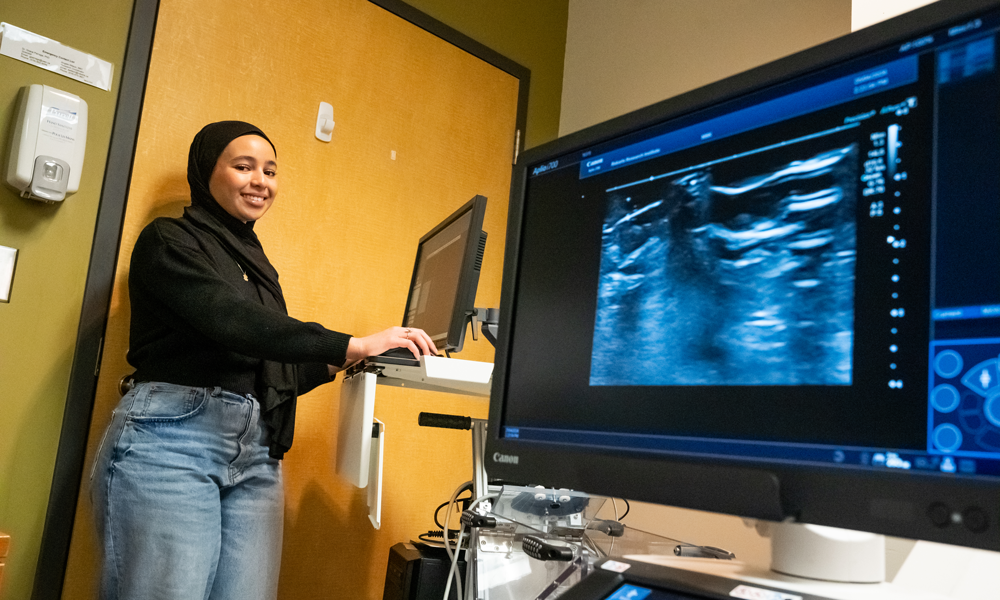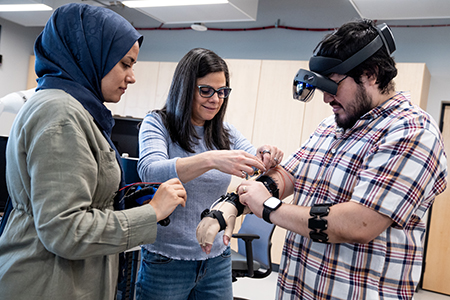Media
Contact
Communications Specialist
Faculty of Engineering
Spencer Engineering Building
Room 2072
Western University
Tel: 519-661-2111 ext. 87015
Email: engineeringcomms@uwo.ca
Western Engineering champions innovations in healthcare research

Masters student Randa Mudathir with ultrasound machine that allows for acquisition and manipulation of three-dimensional ultrasound images. (Jacob Arts photo)
In the pursuit of a healthier and more resilient society, Western Engineering stands at the forefront of ground-breaking research initiatives. Across disciplines, faculty members are driving innovation to address critical healthcare challenges through cutting-edge technology and interdisciplinary collaboration.
Spearheading efforts in healthcare research, Western Engineering is actively engaged in pioneering projects that push the boundaries of knowledge and technology to translate research into practical solutions that positively impact healthcare outcomes.
Shedding Light on Osteoarthritis with NovaVue
Emily Lalone, professor in the department of mechanical and materials engineering and School of Biomedical Engineering at Western University, with her research team and collaborators, address a pressing global health concern: Osteoarthritis.
"We can all relate to the burden of osteoarthritis," she begins, her voice resonating with empathy. "If not ourselves, then our family members who have experienced the burden of having this disease, compromising their ability to perform the basic activities that make life worth living."
With an estimated 500 million people affected worldwide, the need for effective disease monitoring and treatment evaluation is paramount.
“Monitoring osteoarthritis progression and treatment effectiveness using medical imaging remains a significant challenge,” says Lalone. “Options like 2D ultrasound and x-ray radiography are limited compared to MRI, which offers detailed 3D images of joint swelling. However, the cost and limited accessibility of MRIs pose obstacles, particularly in rural or under-resourced healthcare settings.”
Lalone is on a mission to redefine medical imaging for osteoarthritis management and is a co-founder of NovaSonix Healthcare with the CEO and her former masters student Carla du Toit, current students Randa Mudathir and Megan Hutter and Western’s medical imaging and medical biophysics professor Aaron Fenster.
Together, they have created NovaVue which is a cost-effective 3D ultrasound device that offers a comprehensive solution to the challenges of disease monitoring and treatment assessment.
“NovaVue is an accessory 3D ultrasound device that can adapt to any existing 2D ultrasound machine to create 3D images," explained Lalone. “As NovaVue moves the ultrasound probe over a body part, it takes a series of 2D images. Our software then takes these images and puts them together like slides of bread in a loaf. When the 3D image is ready, it can be used to measure the size of joints and organs and measure changes in the body in response to treatment,” she added.
As the global population continues to grow older, there has been a significant increase in the incidence rate of osteoarthritis. As the incidence rate continues to rise, this presents a significant need for more ways to diagnose, treat and monitor disease progression.
There is currently no cure for Osteoarthritis. Du Toit believes that early detection and intervention are crucial for maintaining patient quality of life and NovaVue stands as a beacon of hope in the fight against osteoarthritis.
“Last spring we were successful in winning the Western Bone and Joint Institute Musculoskeletal Innovation Challenge and the prize money and endorsement of the Institute u nderscores the transformative potential of NovaVue in clinical practice,” shared du Toit.
“We are doing a clinical trial right now in collaboration with Dr. Assaf Kadar, who is an Orthopedic Surgeon at the Roth | McFarlane Hand and Upper Limb Centre and working on FDA approval and commercialization, which promises to alleviate the burden of osteoarthritis for countless individuals worldwide,” she added.
Protecting athletes with cutting-edge research
In the realm of sports safety, professor Haojie Mao stands as a guardian, dedicated to protecting athletes, or anyone who plays sports, from the dangers of Commotio cordis. As an enthusiastic researcher in the department of mechanical and materials engineering and Tier 2 Canada Research Chair in in Head Mechanics, Mao's research focuses on unravelling the mysteries of this life-threatening condition, characterized by sudden heart failure due to chest impacts.
"The incident of NFL player Damar Hamlin in early 2023 reminds the public of the terrifying consequence of Commotio cordis," Mao states solemnly. "There is a serious risk of heart failure just seconds after chest impact, and if not immediately treated, it is life-threatening."

(Front) Grant James Dickey, PhD student, School of Biomedical Engineering in
coversation with Jainee Patel, undergraduate student in the department of Biology
while (left from back) Sarang Shin, undergraduate engineering student, Kewei Bian,
post-doc, department of Mechanical and Materials Engineering and Sabine Fedder,
undergraduate biology student, look on (Jacob Arts photo)
Mao's research is not just theoretical; it's actionable. By developing and applying advanced human body models, Mao and his team are uncovering the underlying mechanisms of Commotio cordis, paving the way for data-driven preventive measures.
“While my research is at a relatively early stage, it is the first in the world to use human body models to understand human heart mechanics during Commotio cordis impact,” shared Mao.
“With this knowledge, we will propose data-based testing protocols and designs to reduce the risk of Commotio cordis.”
Collaborations with industry leaders like Bauer Hockey and esteemed institutions like the University of Michigan and the University of North Carolina in the United States amplify the impact of Mao's work. Currently, he is working with his collaborators, and many Western talented trainees such as Grant Dickey, Kewei Bian, Sakib Ul Islam, Sarang Shin and Jainee Patel to reconstruct real-world Commotio cordis accidents and derive the critical limits that the heart can bear, positioning Western Engineering as a global leader in sports safety research.
“Given the widespread participation in sports like hockey, football, baseball, lacrosse, martial arts, among others, our research can help individuals to be appropriately protected and help prevent life-threatening Commotio cordis,” concluded Mao.
Empowering rehabilitation through wearable mechatronics
Shifting the focus to wearable healthcare technology, professor Ana Luisa Trejos , a Tier 2 Canada Research Chair in Wearable Mechatronics in the department of electrical and computer engineering and the School of Biomedical Engineering, leads pioneering efforts in designing intelligent wearable devices to support human health.
"In our lab, we aim to design wearable devices for motion assistance and rehabilitation," Trejos explains. "The use of artificial intelligence is extensive, as the goal is to make the devices as intelligent as possible by responding to the user’s needs or according to a prescribed rehabilitation plan."

(From let) Maedeh Mohammadiazni, PhD student, School of Biomedical Engineering,
Engineering Professor Ana Luisa and Jose Guillermo Colli Alfaro, Postdoctoral Fellow,
School of Biomedical Engineering display a few wearable devices, including the
HoloLens 2, the Myo Armband and their custom TCA-actuated glove for wrist
rehabilitation. (Jacob Arts photo)
Trejos' lab harnesses the power of artificial intelligence to develop devices that respond dynamically to users' needs, aiding in motor skill relearning and rehabilitation progress monitoring. By integrating machine learning algorithms, these devices offer real-time feedback and guidance during exercises, empowering individuals with mobility limitations to regain independence and improve their quality of life.
“For example, we can process muscle activity signals to determine the motion being performed or the intent of the motion, predict the start of tremors by processing motion signals and identify patterns found in the muscle activity data to distinguish different hand gestures that can be used to interface with the devices,” shared Trejos.
She added: “We can also use these algorithms to provide feedback to the user about their performance or their posture when sitting or when performing exercises or use machine learning to identify when a motion being performed is incorrect or can lead to further damage. This all can help to determine if a person undergoing rehabilitation is improving.”
When generating motions by integrating actuators, Trejos contends that we can use machine learning to improve the control of actuators that do not behave linearly, and are thereby more difficult to control, ultimately leading to devices that can respond more intelligently.
These algorithms can be integrated into assistive and wearable devices, playing a significant role in physical rehabilitation by offering real-time feedback and guidance during exercises, assisting patients in relearning motor skills, and enabling healthcare professionals to remotely monitor progress. Employing this technique may empower people suffering from mobility limitations to regain control and independence in their daily activities, positively impacting their overall quality of life and facilitating their reintegration into society.
Western Engineering's commitment to healthcare innovation underscores its pivotal role in shaping a healthier and more sustainable future. Through interdisciplinary collaborations and cutting-edge research initiatives, the faculty continues to drive meaningful change in healthcare practices and outcomes, promising brighter prospects for individuals worldwide.

